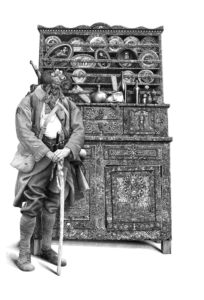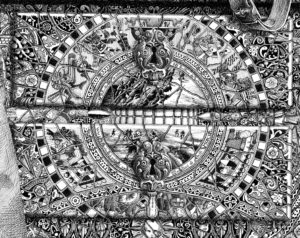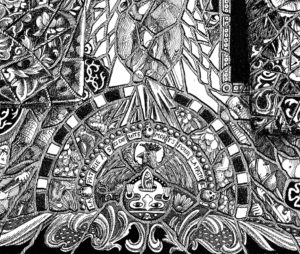 Patriarche n° 1418 – La gueule cassée
Patriarche n° 1418 – La gueule cassée
(Patriarch n° 1418 – The broken Face)
Mad Meg
2020-2021
Indian ink on paper
183 cm x 265 cm
The monumental ink drawing “Patriarche n° 1418 – La gueule cassée” (Patriarch n° 1418 – The broken Face) by the French artist Mad Meg shows a humanlike figure in a military uniform. However, his head is the one of a mosquito, with its left compound eye smashed. He stands in front of a cupboard with porcelain plates, bottles and other utensils in its upper part. The lower section of the furniture has doors and drawers, which are decorated with meticulous mosaics picturing inter alia cherubs and angels reminding putti. There are also floral and ornamental elements. As a whole, the huge oeuvre is executed in a realistic manner with many meticulous details, often allegoric.
As the title with its number indicates, the “Patriarch n° 1418 – The broken Face” is part of a series, where the artist features various prototypes of masculine characters, all with insect heads. However, the title also refers to the present model. Further hints are given by the outfit of the architype and the content of the cupboard. Our patriarch is dressed in a French military uniform from 1914, more precise the uniform of the poilus, the French infantrymen. They were appointed to the forefront, mostly in the trenches. Thereby, they have been sacrificed as cannon fodder. Moreover, the title’s addition “The broken Face” is the designation for veterans of the First World War, who were injured in the face. In contrast to the garment of a simple soldier, there are two plates with depicted militaries in formal uniform, decorated with medals. On another plate, a soldier is polishing a shell. Also the other plates are showing military motives, invented by the artist, but inspired by porcelain of the era. One of them is dedicated to the glory of the heroes (Gloire aux Héros) from 1914 to 1917. Grenades and other ammunition allude to the First World War, too. Two authentic letters from the front are describing war events. There is also a half mask of a man with glasses, which is an accurate picture of a prosthesis, worn by the veterans with face injuries, hence the broken faces. At the same time, the smashed eye of the mosquito head makes an allusion to these hurts. Besides, one plate mentions the Spanish flu. This pandemic, which killed millions of people worldwide, is a reference to the current Covid pandemic and hint to the time of origin of the drawing.
 Additionally, Mad Meg introduced motives coming from the Aztec culture, for example, the stone of sacrifice and Aztec calendar. Originally, in its centre the calendar represents the sun god, who is fed by blood and flowers every morning. He is surrounded by circles of numbers and pictograms symbolising days, “weeks” (trecenas) and “month” (mēztli) of the 365-day calendar cycle (xiuhpōhualli) and the 260-day ritual cycle (tōnalpōhualli). In her version, the artist varies these elements with others. Almost in the centre of the image, on two drawers is a circle with some of these pictograms and in the middle the teeth of the sun god. However, the central round features a battle scene. Whereas at the lower edge, between the doors, is the sun god upside down. Above is the French cook and the pictograms are replaced by floral elements.
Additionally, Mad Meg introduced motives coming from the Aztec culture, for example, the stone of sacrifice and Aztec calendar. Originally, in its centre the calendar represents the sun god, who is fed by blood and flowers every morning. He is surrounded by circles of numbers and pictograms symbolising days, “weeks” (trecenas) and “month” (mēztli) of the 365-day calendar cycle (xiuhpōhualli) and the 260-day ritual cycle (tōnalpōhualli). In her version, the artist varies these elements with others. Almost in the centre of the image, on two drawers is a circle with some of these pictograms and in the middle the teeth of the sun god. However, the central round features a battle scene. Whereas at the lower edge, between the doors, is the sun god upside down. Above is the French cook and the pictograms are replaced by floral elements. Here, the artist uses the attributes of the calendar and with that, the gods hunger for blood as symbol for the bloodshed of war. For her, the origin of wars, are men pretending to defend a territory of which they unjustly claim to be the master or owner. In this way, men are the authors of war crimes, but also the first victims of the war. It is not accidental that the words patriarch, patrie (French for homeland / land of the fathers) and patriot have the same root. The patriarchs send their sons to defend the territory, which they will inherit. When they are fathers, they will do the same and send their sons to kill the sons of the enemy fathers. It is an eternal vicious circle. Mad Meg sees the war as a sacrifice of human beings on a large scale. Thus, the connection from the sacrifice for the Aztec god to the Patriarch n° 1418. Her opposition to war is like that manifested not only in this case. In many of her works there are motives from Aztec culture. It is also evident that the insect head is not accidently from a mosquito, since the animal drinks blood to feed its eggs.
Here, the artist uses the attributes of the calendar and with that, the gods hunger for blood as symbol for the bloodshed of war. For her, the origin of wars, are men pretending to defend a territory of which they unjustly claim to be the master or owner. In this way, men are the authors of war crimes, but also the first victims of the war. It is not accidental that the words patriarch, patrie (French for homeland / land of the fathers) and patriot have the same root. The patriarchs send their sons to defend the territory, which they will inherit. When they are fathers, they will do the same and send their sons to kill the sons of the enemy fathers. It is an eternal vicious circle. Mad Meg sees the war as a sacrifice of human beings on a large scale. Thus, the connection from the sacrifice for the Aztec god to the Patriarch n° 1418. Her opposition to war is like that manifested not only in this case. In many of her works there are motives from Aztec culture. It is also evident that the insect head is not accidently from a mosquito, since the animal drinks blood to feed its eggs.
For the present patriarch, Mad Meg was inspired, by an intense cooperation with Séverine Gambier. During this collaboration, the works of the two artists pervade each other. Séverine, from whom we presented the last artwork of month of March 2022, uses inter alia ancient plates representing masculine personalities. But in opposite to Mad Meg’s illustrations of plates, she breaks the porcelain to recompose it in a new context as mosaic. For the decoration of the cupboard doors, Mad Meg copied two original mosaics by Séverine. Also the rest of the piece of furniture is inspired by the oeuvre of her counterpart. Here, the fragmentation in Séverine’s artistic practice, which refers to breaks in life, becomes a recurring motive. The cupboard is out of balance and one door is unhinged, it is damaged. A mosaic made of broken porcelain covers it. Moreover, the soldier in front of furniture has an injured eye, as many other soldiers like him: the broken faces. He is the prototype of the millions of sacrificed soldiers in the First World War and of any other military confrontation. This is also expressed by the repeated diffractions.
Mad Meg
Born in 1976 in Villeurbanne, France, Mad Meg has an education in fine bookbinding and studied plastic arts. Subsequently, she frequented the Académie des Beaux-Arts of Paris for a short study. Additionally, she worked in the ateliers of the city of Paris, learning nude drawing of living models. In 2001, the artist started to draw in small notebooks (approximately 11 cm x 15 cm) with a ballpoint pen and made around 450 pages until now. Over time, she set about greater formats and replaced the pen by a nib pen. This technique is more archaic than the ballpoint pen and enables a precise and incisive execution. Especially the work on large-sized paper generates a contrast between the meticulous drawing and the monumental format. Thus, the contemplator might be attracted by the dimensions, but could plunge into the details and immerse completely in the image.
Her artist name, is a reference to the painting “Dulle Griet” by Pieter Breugel the Elder from 1563, which is also known as “Mad Meg”. This allusion is on one hand based on Mad Meg’s feminist position, but also in her predilection to this Dutch artist. Other influencing artists are Gustave Doré, Jacques Callot and not surprisingly Hieronymus Bosch. Moreover, she admires various artists using animals as allegory for human beings and she is stimulated by literature. Hence, she also includes these texts in her works. Her sources of inspiration are evident in her oeuvre. She frequently reinterprets masterpieces, for example “The Garden of Earthly Delights” (Hieronymus Bosch), “The Arnolfini Wedding” (Jan van Eyck) and self-explanatory the “Dulle Griet”. In her versions, she includes autobiographic elements alike social criticism on subjects important to her, like feminism, de-colonialism, environmentalism.
This is even truer for her series of patriarchs. Here Mad Meg points to the toxic forms of masculinity. Already the name of the series refers to this. Apart from the ecclesiastic sense, the meaning of “patriarch” coming from Greek is the “chief or father of a family”, often an extended family. His government was and sometimes still is autocratic and tolerates no contradiction. Thus, his influence on the concerned society is enormous.
Mad Meg transfers these qualities to prototypes of chosen groups of the society and calls them patriarchs. Herewith she points to the sometimes hidden operating string pullers in politics, in the Church, in economy and in the informal sector. There is a pater familias, an imperialist, a conservative, a pope, an analyst, a conjurer and the “Patriarch n° 1418 – The broken Face”, which is our artwork of the month in April 2022. All these architypes of masculine characters have a human body with their accessories to recognize them, but the head of an insect. For the artist, they are not disguised men, but insects trying to pose as a human being. Referring to the notion of “bad faith” (French: mauvaise foi) of the French existentialist philosopher Jean-Paul Sartre, these patriarchs are not acting authentically. They are playing a role and adept false values. In doing so, they deny themselves and renounce to the freedom, which is inherent to human beings. Consequently, they are deceiving themselves and the society. Since the individuals behind these prototypes mostly have a big influence, they could harm the society. Mad Meg wants to make aware of this. At the same time, she demonstrates that most powerful people are still masculine.
From 2004 on, the artist participated at numerous group shows and personal exhibitions, first in France, later also in Italy, Switzerland, Slovakia and the Czech Republic. Moreover, she published several artist books and limited printed editions of her drawings. In 2020, entered her “Feast of Fools” (2008 – 2010) in the collection of the Musée des Beaux-Arts de Nancy, France. With 894 cm x 152 cm, it is the – until now – hugest oeuvre. At the same time began her solo exhibition “Margot l’enragée” in the same institution, which lasted until summer 2021. “Feast of Fools” combine two of her described directions in art. On one hand, it gathers thirteen of her patriarchs; on the other hand, it is her interpretation of Leonardo da Vinci’s “Last Supper”. The Galleria Gasparelli exposed Mad Meg together with the sculptor Séverine Gambier at their location in Fano, Italy in 2021. “Dell’ Ornamento” (From Ornament) resulted from a cooperation between the two French artists. “Patriarch n° 1418 – The broken Face” illustrates this collaboration. For a cooperation between the Galleria Gasparelli and the Galleria D406, the original exhibition was enlarged. The result was displayed at the Art Verona in October and at The Others Art Fair in Turin one month later. From November 2021 to March 2022, works of both artists were on view at the “Marginalia” in Pavia, Italy. In May 2022, their works will be with the Galleria D406 on the BOOMing Contemporary Art Fair in Bologna. The artist is represented by the Galleria Gasparelli.
Mad Meg lives and works in Paris.








